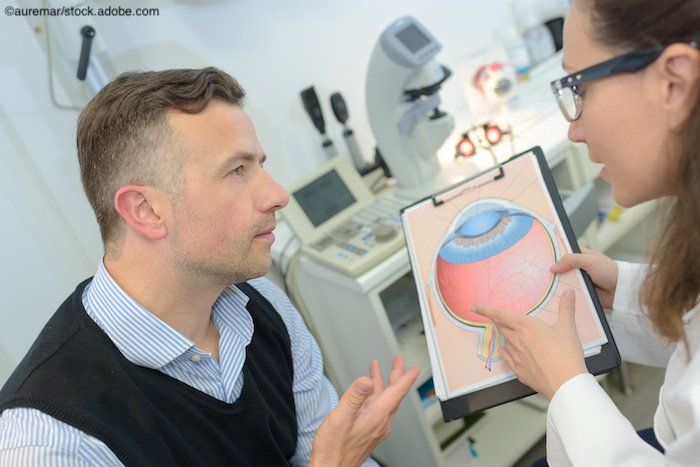Article
Sustained-release delivery systems on horizon of glaucoma care
Author(s):
Novel platforms address adherence; clinicians look to efficacy, treatment duration

The development of sustained-release delivery platforms for glaucoma drugs is in its infancy, but ultimately will solve real clinical problems for patients.
Reviewed by James D. Brandt, MD
Compliance is a huge issue in patients with glaucoma despite the effectiveness of the available anti-glaucoma drugs. However, while no one can argue with the safety and efficacy of the prostaglandin analogues-the first-line treatments for glaucoma-many patients do not, cannot, or will not instill their medications, said James D. Brandt, MD.
If fact, 50% of glaucoma patients are guilty of noncompliance. Sustained-release platforms will help address this problem.
Many such systems are under development, and a few may be commercially available within the next few years, said Dr. Brandt, professor of ophthalmology and vision science, vice chairman for International Programs and New Technology, and director of the glaucoma service, Tschannen Eye Institute, University of California, Davis.
Developing sustained-release platforms is challenging. The primary concerns of efficacy and treatment duration are critical, but they must be balanced with patient comfort, experience, and safety.
“It is my firmly held belief that in early glaucoma and ocular hypertension, safety must take the front seat among all the considerations,” Dr. Brandt said. “In the Ocular Hypertension Treatment Study, we found that we had to treat 20 patients to prevent early disease from developing in one patient.”
This raises the flip side of the question, i.e., What number is needed to harm?
“In early disease, we must be certain we are not placing patients at risk of iatrogenic harm,” he said.
For patients with advanced disease, the risk-to-benefit ratio can change if better efficacy and treatment duration can be achieved.
Development pipeline
A number of approaches can be used to provide sustained-release drugs: some are implantable under the conjunctiva, e.g., erodible drug pellets, drug-containing microspheres, and mechanical drug reservoirs, and some are used externally, such as drug-infused contact lenses placed on the cornea.
Consideration is also being given to intraocular, punctal, and conjunctiva designs, which are among the farthest in the pipeline. An intracameral erodible device, a drug-eluting punctal plug, and a drug-eluting conjunctival ring are either in or near phase III trials and likely to be marketed within a few years, he noted.
As of late 2018, products thought to be available within 3 to 5 years include two anterior chamber biodegradable implants (Bimatoprost SR, Allergan and Travoprost XR-ENV 515, Envisia Therapeutics); a nondegradable anterior chamber implant (iDose, Glaukos); a conjunctival periocular ring (bimatoprost ring, Allergan); and two punctal plugs (OTX-TP, Ocular Therapeutix and Evolute, Mati Therapeutics).
The device closest to commercial availability is the Bimatoprost SR device, currently in a phase III study. The device, which can be injected in the office, continuously releases the drug for a minimum of 6 months. Data obtained in the phase II study of the device showed sustained IOP lowering out to 6 months.
Phase III trials will likely begin soon for a few devices. iDose, a titanium implant, contains at least a 6-month supply of travoprost. The device is placed and can be replaced over time in the trabecular meshwork. Preliminary data currently are unpublished.
The Travoprost XR is an intracameral erodible platform; early phase II data indicate that IOP lowering continued out to 11 months in five patients. The two punctal plugs, OTX-TP and Evolute, are in phase III and II trials, respectively; both deliver prostaglandins and have a targeted treatment duration of 90 days, he noted.
Dr. Brandt has been working with the bimatoprost ring, for which phase II studies have been completed and phase III studies are planned. The device is implanted into the conjunctival fornix and rests under the eyelids.
The device must be replaced by a surgeon every 3 to 6 months. Rings containing more than one drug have been evaluated in small pilot studies.
Reality check
The future of glaucoma therapy seems bright but is not without as-yet unanswered questions. Clinicians should consider the predictability of the treatment duration.
“Until these products have been used for a while, we won’t know how the duration varies among patients,” Dr. Brandt said.
In the absence of knowledge of the real-world duration, patients whose IOPs have increased weeks or months before the label duration can be missed, he said.
When considering any sustained-release platform, it is noteworthy that IOP increases are asymptomatic. Home tonometry is useful in this scenario.
A second consideration is the need to remove the platform if patients experience drug side effects and the consequences of development of cystoid macular edema after a prostaglandin depot is implanted.
About 50% of patients cannot control their glaucoma with only one drug and need two or more to decrease IOP by 20%. He emphasized the importance of not overpromising to patients that they will have a drop-free life.
Sustained-release platforms that are injected are associated with specific questions regarding workflow and safety.
For example, because glaucoma usually occurs bilaterally, should both eyes be injected on the same day? And how is the need for more than one drug addressed? In addition, how many injections can the cornea tolerate? How is the endothelial cell count affected? What are the risks of infection?
The phase III trials cannot answer these questions, only time will provide answers, Dr. Brandt concluded.
Disclosures:
James D. Brandt, MD
E: jdbrandt@ucdavis.edu
Dr. Brandt receives research and travel support from ForSight VISION5 Laboratories, is a consultant and conducts research for Allergan, is a consultant to Aerie Pharmaceuticals, and is a stockholder in and former advisory board member for Glaukos.




